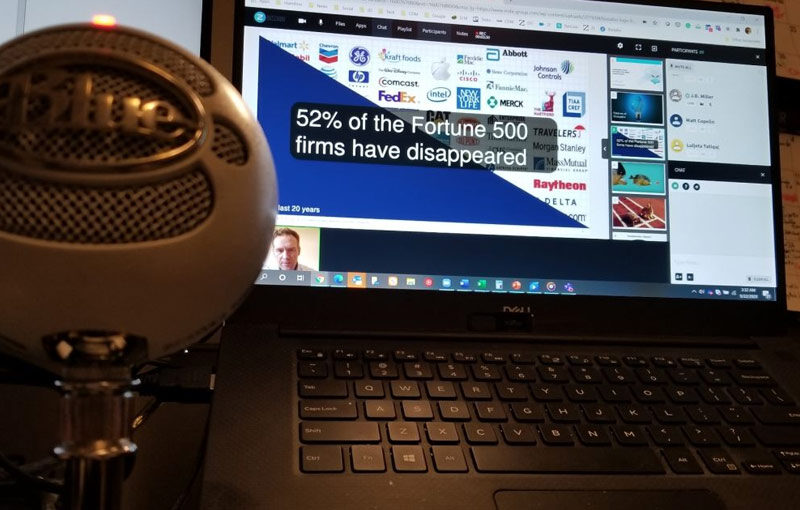“Without people, the technology doesn’t matter.” -Jason Spencer
Jason Spencer spoke at a recent CDM Media Summit – and we wanted to share that conversation with you.
Name: Jason Spencer
Title: Vice President, Global IT at RR Donnelly
To hear more of Jason and J.D.’s conversation, check out Executive Insights: The Intersection of Business Strategy, Leadership, and IT.
Walk us through how the pandemic has changed you and your role.
People say that a global pandemic was not on our checklist for our preparedness. I think the biggest thing is how you can be you wherever you are and still operate. That sounds sort of easy. There are tools, applications, laptops, so you can be portable. But, the rest of the world doesn’t have the same infrastructure as we do, so there are power issues, broadband issues, all sorts of interesting things to consider.
So, we are being faced with challenges, and overcoming them affably by being more open-minded than ever before. The legacy way of approaching how a person executes their work in a very controlled and secured environment, those needs haven’t gone away.
Because we’re so distributed globally now and that changes the topology of your threat landscape. It changes your IT, your endpoints, your ingress and egress points. That’s why you’ve seen a several digit percentage increase in ransomware because now that you’ve got all these entry points with people at home hooked into their IoT on their home networks.
IT was becoming more of a business partner and revenue driver and now it’s even more of a revenue driver and risk-mitigation mechanism. If you’re in IT in 2020, it’s a good spot to be in because we’ve proven as a channel across multiple industries in multiple verticals, that we had the chops to make things work. That’s something that we didn’t get that chance prior to.
Where should we lean harder on technology and where should we lean harder on people?
So without people, the technology doesn’t matter. That’s one of my principles. I can teach tech to anybody but I can’t teach personality. So I look for individuals who are willing to go out and be optimistic and who’re willing to collaborate across teams. We’ve helped develop in our staff active communication, actively reaching out, because many of us don’t have the water cooler talk anymore, there’s no cafeteria talk, there’s no hallway.
Some of the things I’ve put in place include giving people time back, honoring the individual, empowering the professional, making sure that you’re communicating with random people who you may not or may not communicate with on a regular basis. I have a mandate for everybody that’s a team lead and above under my umbrella: they have to talk to five people a week that they don’t normally talk to. I know that sounds simple, but I think it helps keep us going, mentally.
I work for a 160+ year-old company, so as you can imagine we have various tech in play. We’re a tale of two cities in many cases; we’re a cloud leader and we’re also legacy. I’m still running AS400 and mainframes and I’ve got everything you can think of. Part of the challenge that we’ve had is, you can’t just rebuild that monolithic application that’s grown up over the last 20-30 years. It’s cost prohibitive at this point. We’ve invested a lot of time in API source and gateways. We’ve also been able to tie in identity access management, which again is a giant security concern, especially going forward.
Tech departments have begun returning to the office. As leaders, how should we lead differently as people come back in?
Well I think that, I think that people need to realize that folks, some of them have been essentially shell-shocked. There are giant mental health issues out there, and many of them go unreported. I tell all of my staff, “Take a step back, breathe, think about sending out email, because everybody’s got something going on, and you don’t know what that something is. So, use a little bit of grace and be kind, because it pays you back in spades.”
I think the expectation that anybody is going to return to the office bright-eyed and bushy-tailed and happy and they’re just going to show up on time every day when they’re still dealing with all sorts of things. I would say be a little bit lighter hearted. Still concentrate on the mission at hand, and get the job done. But, be kind.
When people go back to the office, some organizations will adapt really well, and others will try their own methods. Do you think we’re on the precipice of a workforce shift?
Dinosaurs come to mind. If you’re going to declare a 100% No-WFH policy when you’ve had a year and a half of people adapting to a new workplace environment, there’s a very good chance they’ll find someplace else. Because that’s real life now. Again, they’ve got pets now, they’ve got kids, they’ve got childcare issues, they’ve got school, they’ve got all sorts of things going on.
Talk to me about how risk tolerance has changed throughout this pandemic.
For us, it’s been increased. We still have the same requirements, the same controls, the goal is still the same. In many cases, we’ve increased scope because we’re subject to every regulation you can think of. We actually brought folks in to look at California privacy laws, GDPR, European and Canadian privacy laws and data residency. The market keeps shifting and it’s all around security and privacy.
You talked about not having the coffee chat or elevator talk, which some feel is essential for innovation, development and brainstorming. Do we need it back?
So, yes, I think that great ideas come from the hallway sometimes. And we’re not in the hallway anymore. Whether you’re using Google, Zoom, Teams, Slack or whatever, all of them have breakout rooms. We have a breakout room where people can just walk in and say, “What about whatever?”, and everybody can see it. I’ve seen that be successful, or you can instantly start a meeting where you’re on camera, so everybody jumps in the room and you just figure it out. Sometimes it’s a problem, sometimes it’s an idea and you get everybody together for a minute. You find alternatives to it. We’ve figured out new and innovative solutions to keep communicating because that’s key.
This conversation has been edited and condensed.



